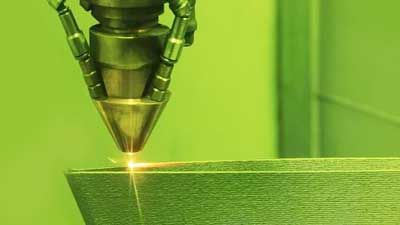| Aug 06, 2020 |
Promising new research identifies innovative approach for controlling defects in 3D printing
|
|
(Nanowerk News) With its ability to yield parts with complex shapes and minimal waste, additive manufacturing has the potential to revolutionize the production of metallic components. That potential, however, is currently limited by one critical challenge: controlling defects in the process that can compromise the performance of 3D-printed materials.
|
|
A new paper in the journal Additive Manufacturing ("Correlations between thermal history and keyhole porosity in laser powder bed fusion") points to a possible breakthrough solution: Use temperature data at the time of production to predict the formation of subsurface defects so they can be addressed right then and there. A team of researchers at the U.S. Department of Energy’s (DOE) Argonne National Laboratory, together with a colleague now at Texas A&M University, discovered the possibility.
|
|
“Ultimately you would be able to print something and collect temperature data at the source and you could see if there were some abnormalities, and then fix them or start over,” said Aaron Greco, group manager for Argonne’s Interfacial Mechanics & Materials group in the Applied Materials Division (AMD) and a study author. “That’s the big-picture goal.”
|
 |
| When 3D printing metallic parts, Argonne scientists found a correlation between temperatures at the surface and defects that form below. (Image: Shutterstock / sspopov)
|
|
For their research, the scientists used the extremely bright, high-powered X-rays at beamline 32-ID-B at Argonne’s Advanced Photon Source (APS), a Department of Energy Office of Science User Facility. They designed an experimental rig that allowed them to capture temperature data from a standard infrared camera viewing the printing process from above while they simultaneously used an X-ray beam taking a side-view to identify if porosity was forming below the surface.
|
|
Porosity refers to tiny, often microscopic “voids” that can occur during the laser printing process and that make a component prone to cracking and other failures.
|
|
According to Noah Paulson, a computational materials scientist in the Applied Materials division and lead author on the paper, this work showed that there is in fact a correlation between surface temperature and porosity formation below.
|
|
“Having the top and side views at the same time is really powerful. With the side view, which is what is truly unique here with the APS setup, we could see that under certain processing conditions based on different time and temperature combinations porosity forms as the laser passes over,” Paulson said.
|
|
For example, the paper observed that thermal histories where the peak temperature is low and followed by a steady decline are likely to be correlated with low porosity. In contrast, thermal histories that start high, dip, and then later increase are more likely to indicate large porosity.
|
|
The scientists used machine learning algorithms to make sense out of the complex data and predict the formation of porosity from the thermal history. Paulson said that in comparison to the tools developed by tech giants that use millions of data points, this effort had to make do with a couple hundred. “This required that we develop a custom approach that made the best use of limited data,” he said.
|
|
While 3D printers typically come equipped with infrared cameras, the cost and complexity make it impossible to equip a commercial machine with the kind of X-ray technology that exists at the APS, which is one of the most powerful X-ray light sources in the world. But by designing a methodology to observe systems that already exist in 3D printers, that wouldn’t be necessary.
|
|
“By correlating the results from the APS with the less detailed results we can already get in actual printers using infrared technology, we can make claims about the quality of the printing without having to actually see below the surface,” explained co-author Ben Gould, a materials scientist in the AMD.
|
|
The ability to identify and correct defects at the time of printing would have important ramifications for the entire additive manufacturing industry because it would eliminate the need for costly and time-consuming inspections of each mass-produced component. In traditional manufacturing, the consistency of the process makes it unnecessary to scan every metallic component coming off of the production line.
|
|
“Right now, there’s a risk associated with 3D printing errors, so that means there’s a cost. That cost is inhibiting the widespread adoption of this technology,” Greco said. “To realize its full potential, we need to lower the risk to lower the cost.”
|
|
This effort is made all the more urgent in recognizing one of the key advantages that additive manufacturing has over traditional manufacturing. “We saw with the recent pandemic response how valuable it would be to be able to quickly adapt production to new designs and needs. 3D technology is very adaptable to those kinds of changes,” added Greco.
|
|
Looking ahead, Gould said the research team was hopeful that what he called a “very, very good first step” would allow it to keep improving and expanding the model. “For machine learning, to build accurate models you need thousands and thousands of data points. For this experiment, we had 200. As we put in more data, the model will get more and more exact. But what we did find is very promising.”
|

